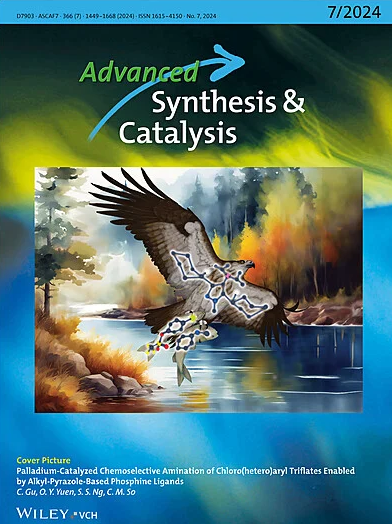无诱骗分子油酸水合物合成小手性醇的结构导向工程
IF 4.4
2区 化学
Q2 CHEMISTRY, APPLIED
引用次数: 0
摘要
小的和手性仲醇是一种广受追捧的化合物,经常用于合成生物活性化合物。然而,它们的立体化学正确合成仍然是化学工业的一个挑战。合成路线受到多个步骤的限制,因而原子效率较低。在这里,我们使用来自脑膜炎脓毒杆菌的油酸水合酶的工程变体,在一个步骤内产生手性C5‐C10仲醇。首先,我们建立了一个两相系统(2‐PS)来捕获易挥发的底物/产物,这些底物/产物促进了酶活性位点和通道的半理性诱变。这些努力使变体的催化活性提高了20倍,ee提高了99%,特别是在没有使用诱饵分子的情况下。计算分析显示了隧道半径、配体输运和能量分布的结构变化,这为解释变体的性能增强提供了线索。有趣的是,扩大反应体积表明产物浓度显著增加,与当前基准相比增加了100倍。这种新的2 - PS和工程酶变体为小型非活化烯烃的可扩展、不对称水合提供了一种有前途的方法,这将大大简化手性醇基信息素或药物的获取。本文章由计算机程序翻译,如有差异,请以英文原文为准。
Structure‐guided engineering of oleate hydrates for the synthesis of small chiral alcohols without decoy molecule
Small and chiral secondary alcohols are sought‐after compounds that are frequently used in the synthesis of biologically active compounds. However, their stereochemically correct synthesis remains a challenge for the chemical industry. Synthetic routes are restrained by multiple steps and thus low atom efficiency. Here we employ engineered variants from the oleate hydratase from E. meningoseptica to produce chiral C5‐C10 secondary alcohols within a single step. First, we established a two‐phase system (2‐PS) to trap the volatile substrates/products which facilitated semi‐rational mutagensis in the active site and tunnel of the enzyme. These efforts led to variants with an up to 20‐fold increase in catalytic activity and >99% ee, notably, without the use of a decoy molecule. Computational analysis indicated structural changes in the tunnel radius, ligand transport and energy profiles, which gave us hints to explain the enhanced performance of the variants. Interestingly, scaling up the reaction volume demonstrated significant increases in product concentrations, leading up to a 100‐fold increase in comparison to the current benchmark. This new 2‐PS and the engineered enzyme variants offer a promising approach for a scalable, asymmetric hydration of small unactivated alkenes, which would drastically ease the access to chiral alcohol‐based pheromones or drugs.
求助全文
通过发布文献求助,成功后即可免费获取论文全文。
去求助
来源期刊

Advanced Synthesis & Catalysis
化学-应用化学
CiteScore
9.40
自引率
7.40%
发文量
447
审稿时长
1.8 months
期刊介绍:
Advanced Synthesis & Catalysis (ASC) is the leading primary journal in organic, organometallic, and applied chemistry.
The high impact of ASC can be attributed to the unique focus of the journal, which publishes exciting new results from academic and industrial labs on efficient, practical, and environmentally friendly organic synthesis. While homogeneous, heterogeneous, organic, and enzyme catalysis are key technologies to achieve green synthesis, significant contributions to the same goal by synthesis design, reaction techniques, flow chemistry, and continuous processing, multiphase catalysis, green solvents, catalyst immobilization, and recycling, separation science, and process development are also featured in ASC. The Aims and Scope can be found in the Notice to Authors or on the first page of the table of contents in every issue.
 求助内容:
求助内容: 应助结果提醒方式:
应助结果提醒方式:


